Table of Contents
Content marketing – it’s a popular approach to boost brand awareness and organic traffic. Despite its popularity, though, the majority (54%) of marketers still view their content marketing strategy as only “moderately successful:”
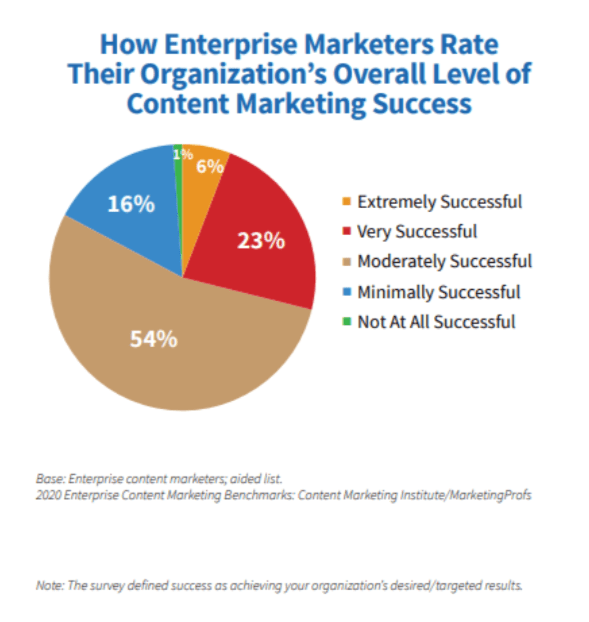
If you feel this way about your own content marketing initiative, consider long-form content creation. Long-form content is proven to be effective because it compiles a lot of valuable information into a single web page. Since readers can get everything they want in one place, this makes for a better user experience, which is at the heart of search engine algorithms. By investing time in long-form content creation, you demonstrate your commitment to user satisfaction, and you can earn better rankings in the process.
What qualifies as long-form content?
Both Semrush and WordStream define long-form content as content that contains 1,200 words or more. HubSpot, though, defines it as a range:
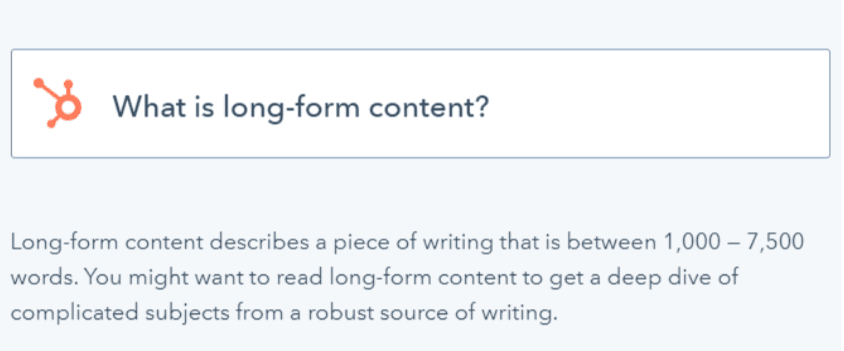
According to BuzzSumo, a page needs to have at least 2,000 words to be considered long-form content. Since this eliminates the ambiguity of a word count range while ensuring that content is long enough to cover a topic comprehensively, we here at Granwehr agree. This definition is supported by the data below.
What the data says about long-form content vs short-form content
When it comes to long-form content vs short-form content, you have to seriously consider the purpose of the page. Your audience may not want or need a drawn-out explanation for each topic on your site. Still, the data shows that long-form content, for the most part, performs better across the board for key SEO metrics.
On average, long-form web pages have higher rankings than short-form pages. A HubSpot social media survey found that a higher word count correlates with more organic traffic:
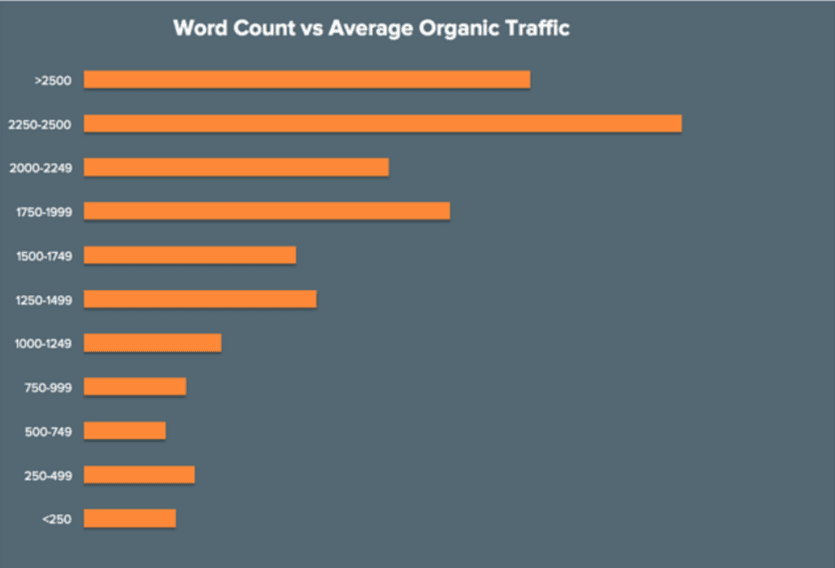
From a backlink standpoint, long content is much more effective than short content. According to a Backlinko content study, long-form posts of 3000+ words receive 77.2% more backlinks than short ones:
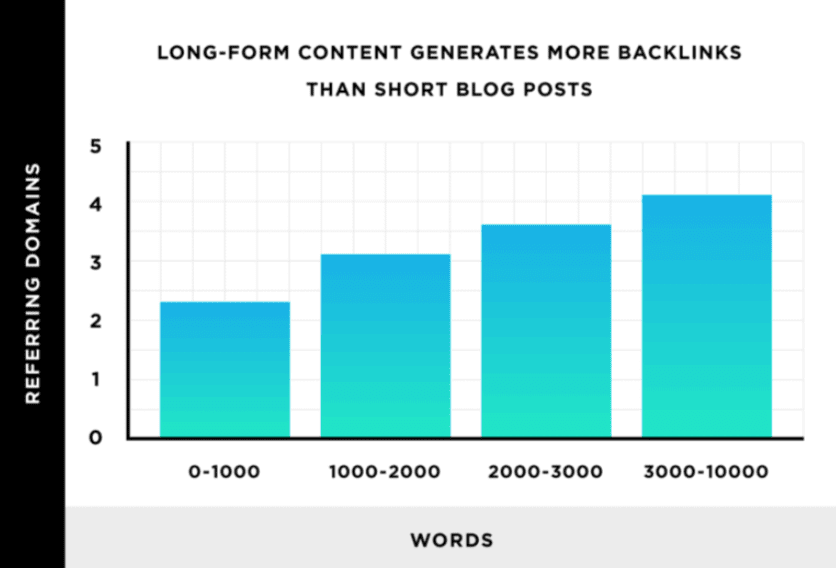
And Ahrefs found a similar correlation between referring domains and content length as well:

According to the data, publishing long-form content is one of the keys to a successful link-building strategy. It may also help you establish authority in your niche faster than if you publish short pieces that only scratch the surface of a topic.
Data analysis from Medium found that the optimal post length is 7 minutes:
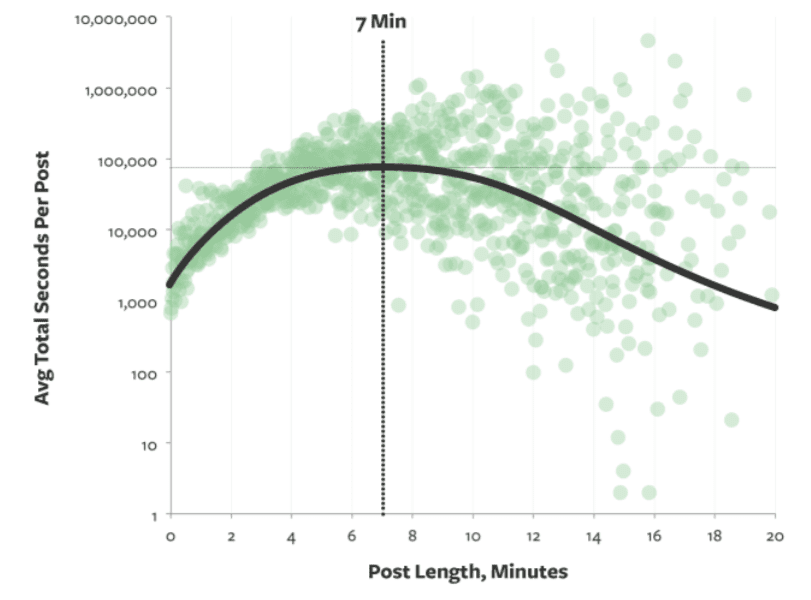
So, while there’s no firm requirement for the length of the content, it’s clear that there are many benefits of long-form content over short-form content.
Why is long-form content effective?
Long-form content is effective because it puts a lot of information in one easy-to-access place. In this way, long-form content has the edge over short-form content, which can negatively impact SEO when used for the wrong topics. If visitors have to go back to search engine results pages (SERPs) repeatedly for the answers they need, this can hurt your SEO rankings. Google may determine that your content provides a poor user experience.
Always consider that aggregating information into one long post can make life easier for users. Take this long-form content from Well Planned Journey as an example:
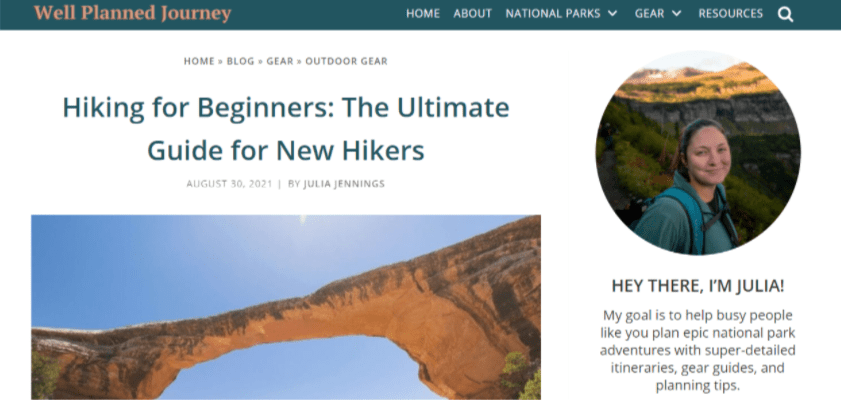
This page is effective because it is user-friendly and comprehensive. Anyone wanting to learn more about hiking would be able to browse this guide and learn all of the basics. This hiking resource is the top-ranking post for its target keywords less than one month after its publish date. This demonstrates how effective long-form content can secure you higher rankings on SERPs.
And for those who say that comprehensive, 2,000-word content is overwhelming to users, it doesn’t have to be. As long as it’s organized effectively, a long-form piece of content can be looked at as several related short-form pieces of content. This can increase dwell time and even bounce rate. As Backlinko points out, when users can’t find a specific piece of information quickly, they might go back to SERPs.
On this page, a table of contents prevents this issue by providing easy navigation:
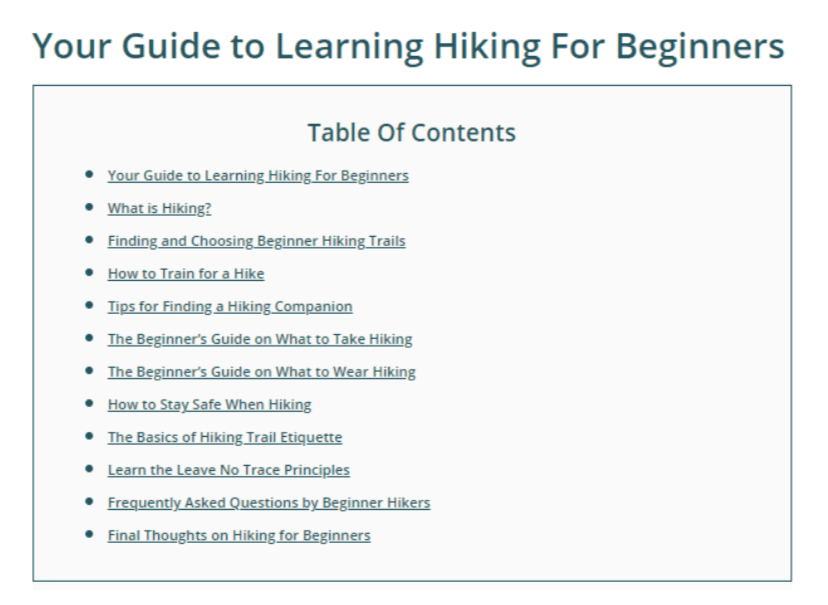
This post is long and comprehensive, but easy to use. It allows readers to skip to the content that is most relevant to them.
When it comes to effective long-form content, the structure is just as important as the information. You need a balance of the two in order to offer crawlers and users organized, valuable information.
How do you know when you shouldn’t create long-form content?
Knowing when and when not to create a long-form resource depends heavily on the topic in question. Technical subjects like cryptocurrency investment, for example, may require more background, definitions, and deep-dive than other topics. You have to consider:
- Is the average user likely to have preexisting knowledge of this topic?
- Does your target audience have the vocabulary to understand this topic without more explanation of key terms?
- Will this topic be a pillar page for your website?
- What are users looking for when they search this term (search intent)?
If the topic doesn’t require more explanation and/or isn’t going to be used as a pillar page, you can consider creating a short-form piece of content for it.
Most importantly, though, you need to understand the search intent behind the topic. Consider two related but distinct search queries:
“Buy dog treats:”
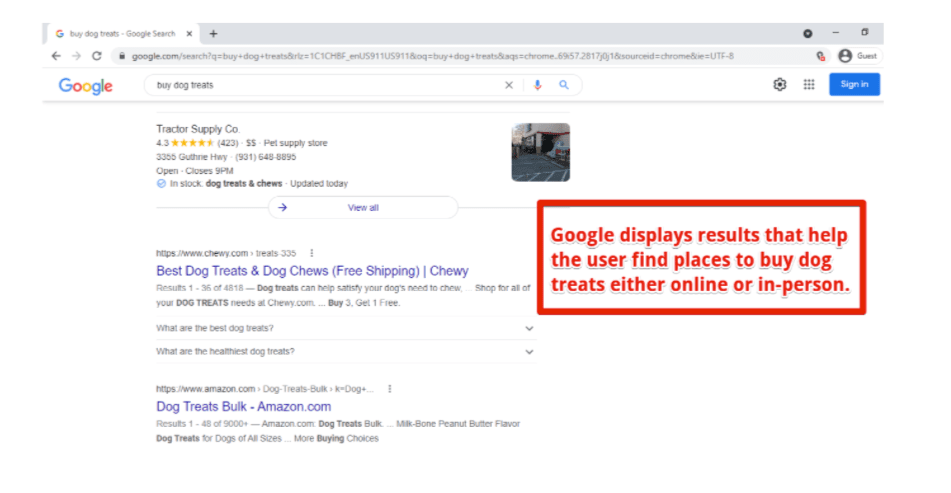
“What’s in dog treats:”
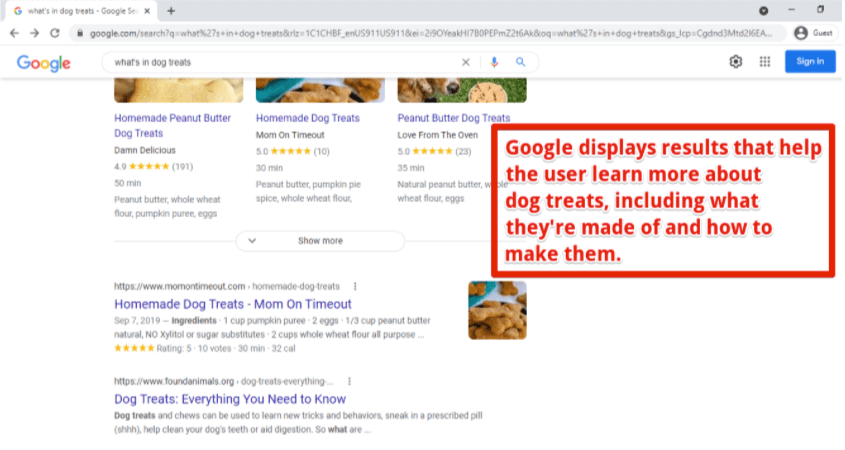
Between these two search terms, you’re more likely to create long-form content for the second one. It wouldn’t make much sense to write a long blog post about the history of dog treats for someone who has clearly already decided to buy some. In that case, you’re better off creating a shorter resource like a listicle product guide to help the user make a purchasing decision.
When it comes to short vs. long-form content, users’ needs are always the determining factor. Make sure that whatever you create aligns with the overall intent of the search term.
How to create a successful piece of long-form content
Planning out your content will make it easier to create. It will also help you develop a content catalog that best represents your brand and makes you an authoritative source in your niche.
The following steps will take you through the process of creating long-form content. Because of its length, long-form content requires a methodical approach.
Start with keyword research
Keyword research is the process of finding search terms that people are typing into Google and that you can write about. It involves looking at current search rankings and user search trends to determine which topics are the best to make content for. These are the first three steps in the research process:
- List out relevant words and phrases to your business or website.
- For each keyword you come up with, brainstorm related topics and words.
- Organize your list into main topics and subtopics (EX. “camping” vs. “best sleeping bags”).
During this process, find keywords that relate to your brand or niche. Just because a keyword has a high search volume and low competition doesn’t mean you should write about it.
Once you’ve compiled a list of keywords, you need to discover the search intent behind them. In other words, why are users looking up the term(s) and what are they hoping to find? You should be able to answer these questions and categorize your target keywords according to their search intent:
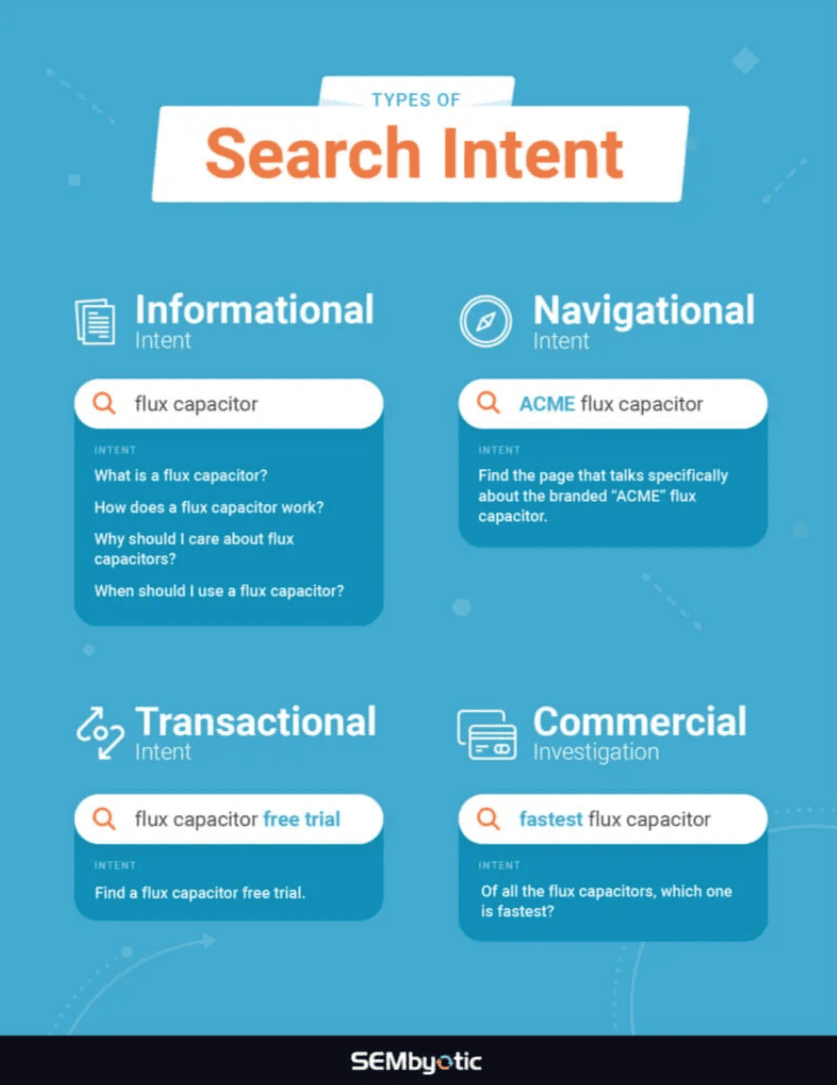
Understanding what the user wants will figure out how to solve their problem. You can analyze the current search rankings to determine what type of content you want to create (tutorial, blog, article, case study, etc.). When viewing top-ranking posts, make note of what style, format, tone, etc. that they use to satisfy user intent.
Take for example the keywords “tropical vacation destinations for families:”
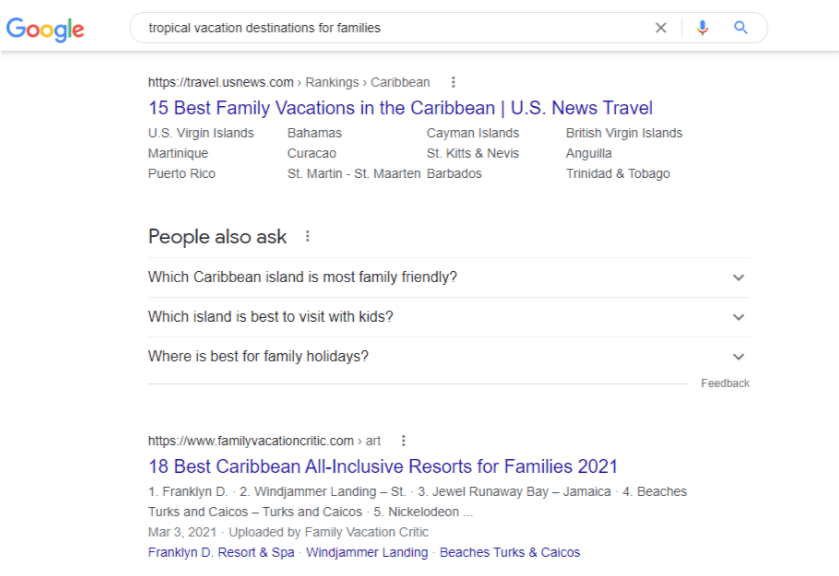
The top results are listicles with both informational and entertaining tones. You can use the “People also ask” section to find related questions that you can answer in your content.
Satisfying user intent is crucial for generating organic traffic because it ensures that your content is something your audience wants to consume. If your long-form content doesn’t solve the user’s initial problem, it will likely produce lower rankings. Google will have no reason to show it to searchers, and this will have a negative impact on its long-term SEO visibility.
Determine goals
What do you want to accomplish with this piece of content? Do you want the user to buy something? To learn something and share the information online? To sign up for a webinar or newsletter?
The overall goal of the piece will determine:
- How you write the content
- The call-to-action that you choose
- How and where you promote it
- The information you include
To do this, you need to define the audience of your content. This means determining things like age, gender, socioeconomic status, etc. Once you know who you’re targeting, you need to figure out where they’re at in their buyer’s journey as it relates to your marketing funnel:
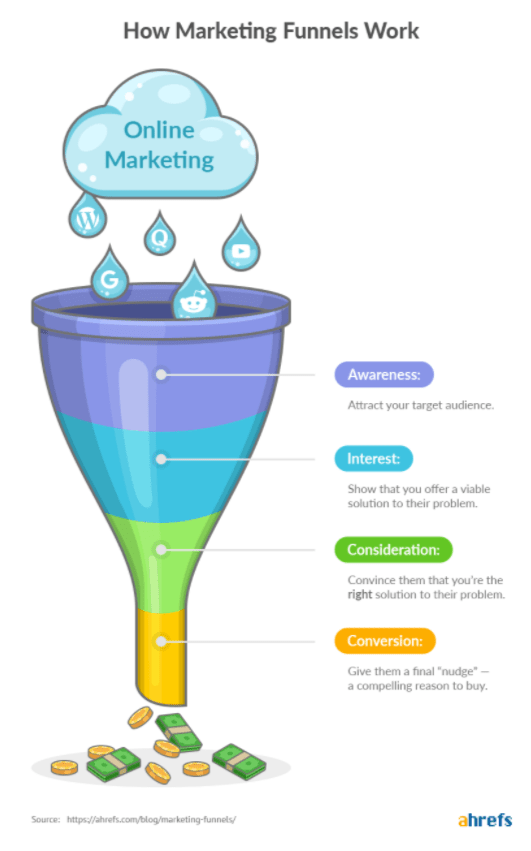
Depending on the stage they’re at, users will be searching different types of keywords in Google. For example, someone in the awareness stage might Google “how long do tires last?” while someone in the interest stage might Google “best tires for my Subaru.”
As you learn more about your buyer’s journey, you need to map related keywords. Keyword mapping is an on-page SEO strategy for deciding what type of content works for your target audience. If you know what users want from their searches, you can create better content for them.
While mapping keywords, you should connect your URLs to related keywords. The goal is to essentially create a template for which search terms go with each piece of content you plan to write:
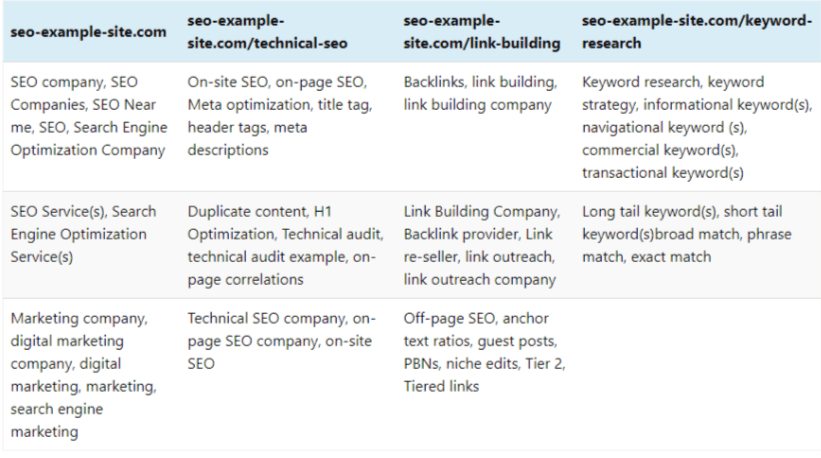
Notice how each URL has a column of related keywords beneath it. These keywords are organized into subtopics.
Take the third column for example. The URL is focused on link building and the potential keywords are divided into three groups:
- General synonyms for link building
- Related keywords for link building businesses
- Important topics related to link building
Keywords mapping is important for ensuring that your web pages don’t compete with each other in search results. By having a detailed plan of what you want to accomplish, who you’re targeting, and which search terms you want to rank for, you’ll be able to create more effective content.
Although keyword mapping may seem tedious, it is essential for developing content that actually makes an impact in search rankings.
Come up with a title
Once you know what you want to achieve with the long-form piece, it’s time to come up with a title for it. Picking a title is an important step in determining the direction of a post. It will help you focus on a specific topic and guide you as you create the content.
The title can be used as both the title tag and H1 tag of the post. Title tags are crucial for getting users interested in your content. They are the hyperlinked text that users click on to get from search results to your website.

Titles play an important role in your SEO because they bridge the gap between search results and your website. They have been shown to improve click-through rates (CTR) for web pages when properly formatted.
Here are some tips for writing a great title for your content:
- Include your target keyword without keyword stuffing.
- Appeal to strong emotions like curiosity and fear.
- Use power words like “captivating,” “essential,” “amazing,” etc.
- Stick to a length of 50-60 characters to avoid having your title truncated in search results.
- Make the topic of the post clear to users.
With a compelling title, you can draw more users to your website. As long as the title accurately represents the content, this can improve your overall SEO.
Create an outline
After determining the purpose and title of your content, it’s important to create an outline. Longer content is easier to put together when you have a clear idea of its structure.
According to Nielsen Norman Group, 79% of users scan text on a web page while only 16% read word-for-word.
When making an outline, consider how you can draw users’ attention to the most important areas of the text. Incorporating highlighted keywords and using the inverted pyramid writing method are just two ways you can do this.
This writing method organizes information according to importance. The most valuable information goes at the top of the page and the less-critical information goes towards the bottom.

This caters to short attention spans. Users who don’t want to read 2000+ words get the most critical information upfront. A good outline should include the…
- Title
- Topic sentence for the post
- Main header
- Subheadings (H2, H3, H4, etc.)
- Ideas for where to place images, infographics, videos, etc.
- Intro and conclusion
- Keywords
- Target word count
- Publishing deadline
Here is a basic example of what that might look like:

Use bullets, numbers, headings, and bold text to break up the page and draw attention to areas of interest. Headings are important for readers to locate important topics within the content. But they’re also helpful for crawlers.
Because headings are HTML tags, crawlers analyze them to better understand the text. When you incorporate headings, you give the search engine more context to be able to rank your content appropriately.
Your outline doesn’t have to be extremely detailed. The goal of the outline is to organize your thoughts before you start putting them together. With a comprehensive outline, you’re more likely to create cohesive, high-quality content.
Compile your sources
The next step is to compile the sources that you want to use in your content. Writing in-depth content allows you to provide a variety of statistics and data to support your explanation of a topic.
Throughout your research, save links to relevant research and information. Save each link as a bullet under its associated heading or section. For each link, write down its target keyword so that you know what it is when you come back to the outline.
For example, if you’re writing a post about Halloween activities and find a pumpkin carving guide, label the link as “pumpkin carving:”

This keyword will serve as the anchor text that you use when you include the link in your long-form post.
When analyzing current rankings for your target keyword, make note of common threads between top posts. Then, go past the first page of search results. There you will find more unique facts, case studies, images, etc. that you can use in your content.
You need to add your own information, explanations, etc. as well. If you’ve done your own research or created a high-quality infographic, don’t forget to include it. Pairing essential information from top-ranking posts with proprietary data or unique perspectives is an easy way to set your content apart from the rest.
Write your content
You should now have all the pieces you need to write your content. One of the best approaches is to write a first draft quickly. This helps you avoid overthinking and generally gets the most important ideas on the page first.
Once you have a draft, you can go through and finesse it by adding images, restructuring details, and expanding on your initial explanations. Here are some tips for writing great content:
- Match the tone to your audience. For whitepapers and academic sources, take a more formal tone. For blog content, consider a conversational approach.
- Add your target and related keywords. A tool like Clearscope can help you keep track of which terms you have and haven’t used yet.
- Chunk your content into short, easy-to-digest paragraphs.
- Use bullets.
- Aim for a keyword density of 1-2% (1 keyword for every 100 words).
- For long-form content, shoot for a word count of 2000+.

Don’t forget to keep user experience at the center of your writing. Use simple sentences to get your point across and make sure to draw attention to big topics with headings. This will make it easier for users to skim longer content for the specific information they’re looking for.
Include images
Content marketers rely on visuals to make more engaging long-form articles and blog posts, as these elements diversify the look of the page. Infographics are essential for user comprehension, especially when it comes to long pages of text.
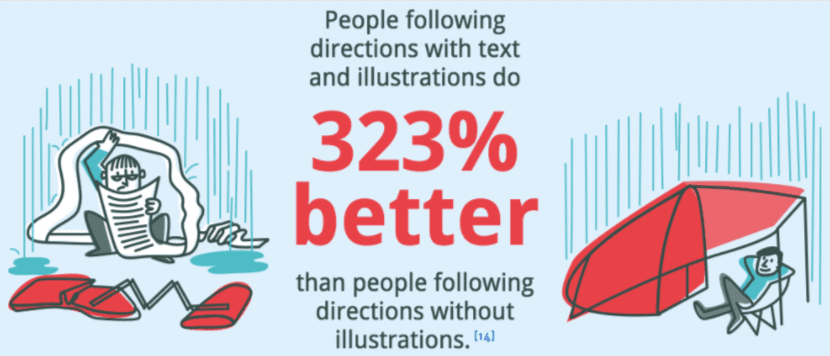
You should look for color images, as they are more engaging and user-friendly. Neil Patel has a great color image guide that explains how choosing color images can actually increase conversion rates.
Once you’ve chosen your visual content, don’t forget to apply these image optimization techniques:
- Put alt text on each image to improve its accessibility and to explain it to search engine crawlers.
- Change the image’s file name to include target keywords or relevant terms.
- Compress images so they take up the least amount of space possible. This helps your website load faster.
- Make your images responsive for mobile devices.
- Turn on browser caching so that the images load faster for users.
Remember, the best images are the ones that add value to the text. Fluff images are popular in blogging content, especially for getting more social shares. For long-form content, however, using too many fluff images can detract from the quality of the content itself.
Add links
Don’t forget to add internal links to your content. They are valuable for several reasons:
- They make it easy for Google crawlers to find your other pages.
- They transfer link equity from one page to another.
- They help users discover and research related topics that you’ve already written about.
When you follow the topic cluster model, you want to make sure that you have internal links connecting your long-form pillar pages to the related content in your site. This ensures that users can get from the main topic to any connected topic just through internal investigation.
If you don’t have a web page for a term that users need more information on, use an outbound link. Make sure to link out to only quality content so that users have the best experience possible.
Include CTAs
You should always have a call-to-action (CTA) – even if you are creating informational content. Without a CTA, you leave to chance the opportunity to win new subscribers, sell products, and generate new leads.
You should always include a CTA at the bottom of the page. This leaves the user with something tangible that they can do to interact with the content.
For example, you can invite users to follow you on social media, sign up for a newsletter, or leave a comment on the page. In this example from Vanillapup, the author includes two CTAs at the end of the content:

You may want to put a CTA at the top of the page where users don’t have to scroll to see it. Most brands include a button that users can click on so they can act on the CTA. This prioritizes the CTA before the user has even read the page.
It’s also a good practice to include your CTA naturally throughout your posts in text. Additionally, though pop-ups can detract from user experience if used too often, when used sparingly, they are a great way to highlight your CTA. As long as these notifications don’t interrupt the page too much, they can actually improve conversions by more than 18%.
Optimize for SEO
As you develop your long-form content, you want to make sure that it’s optimized for SEO. There are several basic SEO areas that you should optimize:
- Schema markup: Add it to your HTML data so that crawlers can have a better understanding of the page.
- URL: Keep it as simple as possible and don’t forget to include your target keyword.
- Meta description: Tell the user what they will get from the content and also use your keyword(s) so the search engine understands the page’s main topic.
- Images: Add alt text to make sure that both crawlers and visually impaired users can understand them.
- Title tag: Make sure it is inviting to users and is 50-60 characters long.
- Duplicate content: Be sure to add canonical tags to any duplicate content so that it doesn’t confuse search engines.
- Page layout: Use headers, bullets, images, etc. to break up written content.
- Responsive design: Adjust your page’s layout, text sizing, etc. to accommodate mobile devices like phones and tablets.
Paying attention to these details may be the difference between ranking on the first SERP or being lost on the second, third, or fourth one. If you want your long-form content to rank, you have to make sure you execute your SEO strategy at the most basic level. Your content needs a solid foundation to stand out on SERPs.
Promote your content
To reach a wider audience, promote your content online. Social media platforms like LinkedIn, Facebook, Instagram, etc. are the most popular places to share content. You can also promote your content on message boards within your niche.
Right now, social signals aren’t an official Google ranking factor, but they are a Bing ranking factor. Show the algorithm that you have a strong connection with your audience by sharing your content on other platforms. You can even partner with social media influencers to extend your reach and tap into new markets.
Promoting content is an important digital marketing strategy for earning backlinks from other websites. Plus, it increases brand awareness over time.
KPIs for long-form content
Measuring the success of your page ultimately depends on your goals. Some general key performance indicators (KPIs) that you should analyze include:
- Time on page
- Bounce rate
- Page speed
- Organic traffic
- Click-through rate (CTR)
If you want to increase brand awareness you can track metrics like:
- SEO visibility
- Domain authority
- Social media follower counts
- Number of impressions
- Homepage visits
- Number of new referring domains
If your goal is to increase subscriptions for a newsletter or podcast, you can track the total number of conversions from the time that your new content is posted. You want to make sure to record your metrics before you publish the content. Google Analytics is one of the easiest places to do this, as it monitors a wide variety of site metrics at all times.
Tools to help with long-form content
Creating long-form content is no small feat. Use some or all of these tools to make the process easier:
- Canva for designing infographics
- Grammarly for editing written content
- Moz Keyword Explorer for finding the best keywords
- Crazy Egg for doing user experience audits on your site
- Hemingway Editor for analyzing your content’s readability
- Semrush for tracking SEO progress and managing your backlink profile
- Google Mobile-Friendly Test for ensuring your site’s responsiveness
Perfecting long posts can be difficult when there is so much content to review. But these and other resources will help you audit your content in a shorter amount of time.
Get a complimentary SEO audit
Content marketing is a term that encompasses many different strategies, and it can be difficult to find the right combination for your brand. If you feel like your strategy needs a boost or a new approach, try creating some long-form content. You may find that it has a significant impact on your search rankings, attracting new website visitors in the process.
Want to see how you’re doing with SEO? Get an instant SEO audit below. Or, schedule a free consultation to see how intent SEO can boost search traffic revenue by 700%.
